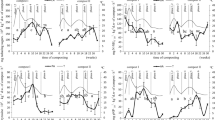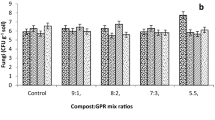Summary
Biochemical changes during composting of kallar grass (Leptochloa fusca L. Kunth) were studied for twelve weeks. Some criteria based on cation-exchange capacity, acid-hydrolysable carbon, lignin-humus complex, humic acid and cumulative CO2-C evolution were established for assessing the stability of kallar grass compost. Sequence of changes in different chemical and biological parameters indicated that the compost was stabilized in six weeks.
Résumé
Les modifications biochimiques au cours du compostage du kallar-grass (Leptochloa fusca, L. Kunth) ont été étudiées pendant douze semaines. Plusieurs caractéristiques, comprenant la capacité d'échange de cations, l'hydrolyse acide du carbone, le complexe lignine-humus, les acides humiques et le dégagement de CO2 on été établies pour évaluer la stabilité du compost de kallar-grass. La séquence de ces différents paramètres chimiques et biologiques montre que le compost est stable au bout de six semaines.
Resumen
Se han estudiado los cambios bioquímicos que tienen lugar durante y el compostaje del kallar (Leptochloa fusca L. Kunth) durante un periodo de 12 semanas. Se establecen criterios para valorar la estabilidad del compuesto, basados en: la capacidad de intercambio catiónico, el carbono ácido hidrolizable, el complejo ligno-húmico, los ácidos húmicos, y la evolución acumulativo C-CO2. La secuencia de cambios en los distintos parámetros químicos y biológicos indican que el compuesto se estabilizó en 6 semanas.
Similar content being viewed by others
References
Anderson, J. P. E. 1982 Soil respiration. InMethods of Soil Analysis. Part 2, ed. Page, A. L. pp. 831–871. Madison, Wisconsin: ASA, SSSA Publishers.
Anon. 1975Standard and Suggested Methods. Georgia: Technical Association of Pulp and Paper Industries.
Bremner, J. M. &Mulvaney, C. S. 1982 Nitrogen-total. InMethods of Soil Analysis Part 2, ed. Page, A. L. pp. 595–662. Madison, Wisconsin: ASA, SSSA Publishers.
Elserafy, Z. M., Sombol, H. A. &Eltantawy, I. M. 1980 The problem of water hyacinth in rivers and canals. I. Production of compost from plant.Soil Science and Plant Nutrition 26, 135–138.
Franklova, S. &Novak, B. 1967 The effect of different temperatures on the humification of organic matter. InStudies about Humus, ed. Novak, B. & Rypacek, V. pp. 175–178. Prague: Czechoslovak Academy of Agriculture.
Gomez, R. J. H. &Park, Y. K. 1983 Conversion of cane bagasse to compost and its chemical characteristics.Journal of Fermentation Technology 61, 329–332.
Harada, Y. &Inoko, A. 1980 The measurement of the cation-exchange capacity of composts for the estimation of the degree of maturity.Soil Science and Plant Nutrition 26, 127–134.
Hileman, L. H. 1980 Composting agricultural residues.Compost Science/Land Utilization 21, 49.
Hussain, M. & Hussain, A. 1970 Chemical analysis of kallar grass.Directorate of Land Reclamation Pakistan Research Publications (Lahore) 11, (49).
Lossin, R. D. 1971 Compost studies. II.Compost Science 12, 12–13.
Malik, K. A. &Sandhu, G. R. 1973 Some studies on the fungi of kallar grass (Diplachne fusca (L.) p. Beauv.) compost.Pakistan Journal of Botany 5, 57–63.
Malik, K. A., Bhatti, N. A. &Kauser, F. 1979 Effect of soil salinity on decomposition and humification of organic matter by cellulolytic fungi.Mycologia 71, 811–820.
Marcixzewska, S. M. 1965 New method for determination of the maturity of compost based on the determination of carbon dioxide.Gaz, Woda i Technika Sanitarna 39, 57–63.
Poincelot, R. P. 1972The Biochemistry and Methodology of Composting. Bulletin 727. 38 pp. Connecticut Agricultural Experiment Station.
Sandhu, G. R. &Malik, K. A. 1975 Plant succession—A key to the utilization of soils.Nucleus 12, 35–38.
Schnitzer, M. &Khan, S. U. 1972Humic Substances in the Environment. New York: Marcel Dekker, Inc.
Shirlaw, D. W. G. 1969 The characterization of carbohydrates. InA Practical Course in Agricultural Chemistry. ed. Shirlaw, D. W. G. pp. 122–130. Oxford: Pergamon Press.
Solbraa, K. 1979 Composting of bark. III. Experiments on a semi-practical scale.Meddelelser fra Norsk Institutt for Skogforskning 34, 387–439.
Spohn, E. 1969 How ripe is compost?Compost Science 10, 24–26.
Steel, R. G. D. &Torrie, J. H. 1960Principles and Procedures of Statistics. New York: McGraw-Hill Book Co. Inc.
Torok, L. &Csonkareti, K. 1963 Determination of carbon in composts by measuring oxygen consumption with a dichromate method.Agrokemia es Talajtan 12, 631–642.
Author information
Authors and Affiliations
Rights and permissions
About this article
Cite this article
Mahmood, T., Azam, F. & Malik, K.A. Biochemical changes during composting of kallar grass (Leptochloa fusca L. Kunth). Mircen Journal 3, 421–428 (1987). https://doi.org/10.1007/BF00935700
Received:
Revised:
Accepted:
Issue Date:
DOI: https://doi.org/10.1007/BF00935700




